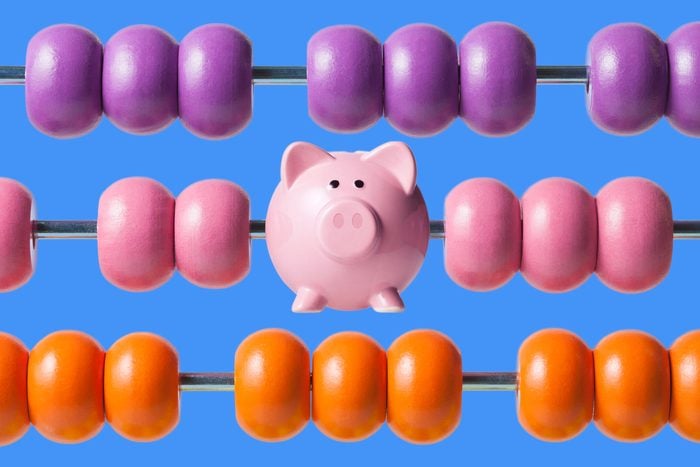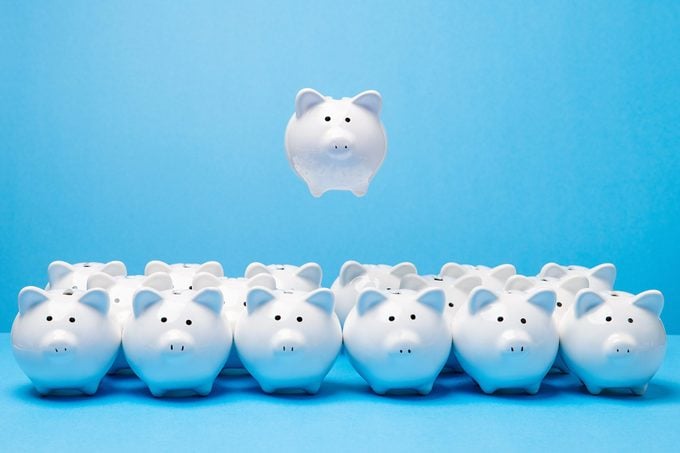How to Save Money Practically Everywhere: 25 Proven Strategies
Updated: Mar. 14, 2024

No drastic lifestyle changes needed! These simple steps add up to significant savings over time.
If you’ve spent the last year feeling like you just can’t get ahead, welcome to the club. Thanks to rising inflation, saving money has been harder than ever. According to the latest Consumer Price Index updates from the U.S. Bureau of Labor Statistics (BLS), the prices of, well, pretty much everything have skyrocketed. Just look at the cost of milk, which has gone up 16.4%, or the cost of electricity, which is up 13.7%, over the past 12 months.
And on top of dealing with inflation, shoppers are also being hit by shrinkflation, which is when you pay the same (if not more) for less product, like cookies in a smaller package or potato chips in a smaller bag. Needless to say, consumers are getting the short end of the stick—they can avoid brands engaging in shrinkflation by paying attention to websites like Mouse Print. And as impossible as it may seem right now, figuring out how to save money has become more important than ever, whether you’re saving to buy a house or building a financial cushion.
By now, you’re probably used to hearing the same old advice when it comes to saving money: Stop eating out, cut cable and learn how to coupon. These ideas for saving money will definitely help, but they are far from your only options. We checked in with financial experts—including Chelsie Moore, director of wealth management solutions at Country Financial, a financial services company, and Snigdha Kumar, financial health expert and head of product operations at Digit, a budgeting app—to discuss their favorite tips for saving money. They’ve provided advice for saving on everything from groceries and clothing to big-ticket items and utilities. If you’re really in a bind, find out how to make extra money fast.
1. Make over your grocery list
The cost of groceries has gone up more than 12%, per the BLS, but there are plenty of simple ways to lower your grocery bill. The best strategy is to make a budget grocery list, including frozen fruits and veggies along with fresh, in-season produce, sustainable seafood and cheaper cuts of meat, such as pork shoulder or London broil. Just make sure to avoid oranges amidst an orange shortage sending prices up. You’ll also want to skip things like prepackaged shredded cheese and yogurt singles that can be more expensive. Moore also recommends stocking up on pantry staples whenever you come across a good sale. Use our ultimate budget grocery list to save big during your next food shopping trip.
2. Switch up stores
While it’s certainly convenient to shop at your neighborhood grocery store or place a Whole Foods order via your Amazon Prime account, chances are you’re paying a premium. That’s why Kumar recommends changing where you get your groceries. “If you’re shopping at more premium grocery stores like Trader Joe’s, Whole Foods or even farmers markets, consider going to lower-cost mom-and-pop stores or wholesale retailers like Walmart and Costco instead,” she says. Moore adds that warehouse clubs also great for cheap groceries, and a gasoline at a discount as well.
3. Break up with name brands
If you’ve been loyal to a particular brand of ketchup, beans or other commercial staple, it may be time to branch out. Store brands or private labels, such as Costco’s Kirkland Signature or Target’s Market Pantry, can be just as good as big-name brands. In fact, they may actually be the exact same thing; Moore notes that some store-brand products are made by the same manufacturer as the bigger-name brands. In that case, you’re literally just paying more for a label. Speaking of paying more, here are the grocery store items with the highest markups.

4. Make time to meal plan
Though it requires an investment of time and effort, meal planning can save you thousands of dollars a year. Kumar advises building meals around discounted items or weekly specials. “Many stores have a weekly discount on certain food items. If you can be flexible with your meal plans and adjust to what’s on sale in any given week, it can save you serious bucks,” she says. Not sure where to start? Here’s everything you need to know about how to meal plan to save money.
5. Seek out “ugly” produce
Buying produce that’s in season is one way to save money at the grocery store, but it’s not the only way. “Farmers are forced to discard not-perfect-looking or so-called ‘ugly’ produce when they sell to grocery chains,” Kumar explains. “These are perfectly good produce, just not in the expected shape or size, so they are a lot cheaper to buy. You can use programs like Imperfect Foods or Misfits Market to snag these grocery items at a 30% to 40% discount.” Bonus: You’ll be helping to reduce the amount of food waste that winds up in the landfill.
6. Pass on the “chef’s recommendations”
Chain restaurants have entire departments of folks whose job it is to convince you to part with more of your hard-earned cash every time you go out to eat. One of the ways restaurants trick you into ordering what’s most profitable for them is by labeling a dish “chef’s recommendation,” or “house specialty.” This dish might feature ingredients they have on hand that are about to go bad or ones they get at a heavy discount from a supplier. Unless it’s a meal you’re truly in the mood for, stick with your standard favorite.
7. Discover the joy of secondhand
Buying secondhand at online thrift stores is a great way to save money, especially if you have kids, since they outgrow things so quickly, according to Moore. But kids clothes or a capsule wardrobe aren’t the only things you should be buying used. If you’re focusing on how to save money, consider seeking secondhand sports equipment, cars, furniture, toys and bikes. In fact, here’s a complete list of items you should buy used instead of new.

8. DIY your dry cleaning
Instead of shelling out upward of $15 to have that cashmere sweater or silk dress dry-cleaned, learn how to—safely—wash it at home. If a care label on an item of clothing says “dry-clean” (vs. “dry-clean only”) you should be able to hand-wash it—and save a bundle. Find out how to wash cashmere, wool and silk at home.
9. Invest in reusables
We all love the convenience of disposable things, but if you’re looking for ways to save money, opt for reusable items instead of disposable ones, Moore suggests. For instance, rather than use a paper towel to wipe down surfaces, use a rag or kitchen towel that can be washed and reused. Word of caution: Switching over to reusable water bottles, straws, microfiber towels and more can have a bigger upfront cost, though you’ll more than recoup that investment over time. And you may not have to buy as much as you think. Check out this list of household items you had no idea were reusable.
10. “Clip” digital coupons
Want to know how to get coupons? Forget the weekly circular—it’s all about digital coupons now. Download your local grocery store apps for instant savings. “You can use apps like Flipp or Ibotta to clip savings or find more attractive discounts for your staples at different stores,” Kumar says. “It gives you the option to search for stores with the best discounts on the items you need the most.” These easy ways to save $20 a day might come in handy, too.
11. Put your smartphone to work
Some cash-back apps like Rakuten or Cently can do double duty in the money-saving department. Not only do they give you cash back on your purchases, but they’ll also find and apply discount codes for you at checkout. These apps are often free and will deposit the cash you’ve earned right into your preferred account. Oh, and did we mention that you can often find promos on these apps? For instance, if a retailer typically offers 2% cash back, they may up that amount to 10%, 15% or as much as 20% back during a holiday or sale, so be sure to check them regularly. Download these best budget apps to make the most of that extra money in your account.

12. Time your chores wisely
With electricity costs up more than 13% in the last 12 months, you’ll definitely want to keep a closer eye on your usage, and the same goes for water. According to Kumar, there are a few things you can do to keep your electric bills in check, aside from investing in a brand-new Energy Star appliance. “Consider doing household chores like laundry, dishwashing and cooking after 7 p.m., when the cost of electricity is typically lower,” Kumar says, and unplug electronics when you’re not using them, since they still draw electricity even when turned off.
When it comes to water conservation, use your dishwasher as opposed to washing dishes by hand with soap and water. “Surprisingly, dishwashers use less water than washing utensils by hand,” Kumar notes, with the caveat that the machine should be full before you run it.
13. Comb through your monthly bills
Take a close look at each of your monthly bills: Are you paying for add-ons or additional services you might not need or use? If so, cancel them. Also, be on the lookout for any cost-recovery fees a company has added to your bill—companies are allowed to pass their increased costs on to you, but you may be able to have them removed, according to Moore. First, find out if those fees are a percentage of your bill or a flat rate, then do some price shopping to compare rates with other companies in your area to see if they’re charging similar fees. Once you have all that information, you can go back and negotiate with your provider to remove the fees.
14. Shop around for better rates
It’s not just the added fees mentioned above but also basic services, including cell service and home and auto insurance, that you may be paying too much for. Yep, it can be time-consuming to shop around, but it’s well worth the effort. A Value Penguin survey found that 92% of people who switched auto carriers during their renewal period saved money, and of those, 26% saved $200 or more annually.
15. Fill up your tank for less
Gas prices can fluctuate wildly, even within a one-square-mile radius. Take the guesswork out of filling up at the pump by downloading one of the best gas apps. Keep in mind, though, that it’s not worth driving five-plus miles out of your way to save 20¢ on a gallon of gas. On the other hand, if you know there’s cheap gas near a destination you were headed to anyway, go for it.
16. Cancel subscription services you’re not using
Remember that time you signed up for a subscription TV channel just so you could watch that one show? Review each of your subscription services, and cancel any you’re not currently using. And if you do sign up for a free trial, set a reminder in your phone for the day before it runs out, when you’re scheduled to be charged. That way you have enough time to decide whether or not the subscription is worth paying for. If it’s not, you’ll want to know how to cancel subscriptions on your iPhone.
17. Give your home an energy makeover
Keeping your house as energy efficient as possible is another way to help lower your monthly bills. Moore suggests swapping your current lightbulbs for energy-efficient bulbs, closing blinds to lower heating and cooling bills, relying on fans and using a smart thermostat to control and maintain the temperature in your home. Here are even more ways to lower your household bills.

18. Shop before you’re in need
When it comes to big-ticket items like appliances, water heaters and well pumps, start looking before you actually need said item, to ensure you get the best price. Because if you wait until it becomes an emergency, you’re more likely to pay top dollar for a replacement, Moore cautions. You’ll also want to be sure you’re buying at the right time. Find out the best months to buy just about everything.
19. Label your credit cards
If you like to take advantage of rewards credit cards, consider labeling each card to keep track of where it will score you the most points. For example, place one sticker on your best gas credit card, another on your best credit card for travel, one on the card that offers the best rewards for groceries and so on. Labeling your credit cards allows you to get the most out of all the rewards programs associated with each of your accounts.
20. Make friends with the public library
Want to know how to get free stuff? Start at your local library. In addition to offering things like free audiobooks and access to free online books for kids, your public library offers a ton of other money-saving opportunities. Borrow books, movies and music for free, and gain free access to various online reading sites like Libby or Bookflix. But that’s not all. Many libraries offer passes that will get you free or heavily discounted admission to local museums, theaters, zoos, aquariums and amusement parks.
21. Think twice before signing up for a “buy now, pay later” program
“Buy now, pay later” (BNPL) programs likely sound too good to be true because, well, they are. According to Kumar, “these programs attract customers with a promise of 0% APR and convenience. You get instant gratification from buying your favorite goods without having to fully pay for them or having to fill out long loan applications.” While it sounds great at face value, Kumar goes on to add that because the process is so seamless, many people don’t even realize that they’re taking on debt. “It is very easy for people to fall into a debt trap, as they don’t fully contextualize the total debt they have and how often they need to pay it back,” she explains.
Another reason to avoid BNPL? According to Moore, you don’t have the same consumer rights that you have with a traditional credit card, so you can’t do things like dispute a charge. And while BNPL programs won’t help your credit score if you’re paying them down, they will negatively impact your credit score if you miss a payment. So if you have your eye on something big, consider creating a sinking fund rather than using a BNPL program.

22. Take your side hustle seriously
If you want to know how to make money fast, a reliable side hustle is your best bet. But with new IRS rules in 2023, using PayPal or Venmo for both business and personal payments will make tax filing more complicated, and it may lead to an IRS inquiry, cautions Kumar. Instead, she recommends getting a business bank account or having a separate payment method for personal expenses as well as business expenses. “For example, you can use Cash App for side hustles and Venmo for personal payments. This will reduce the risk of your personal payments being seen as ‘income’ by the IRS and will also make tax reporting much easier,” she explains.
Moore also advises treating your side hustle like a real business by keeping track of all business expenses and working with a CPA who can help find ways to lower your tax deduction for your specific business.
23. Squirrel away those pre-tax dollars
Whether you have a lucrative side hustle or just your everyday nine-to-five job, you can save money by contributing pre-tax dollars to a retirement account, says Moore. Bonus: Putting pre-tax dollars into an IRA or work-sponsored retirement plan actually reduces your taxable income. In 2023, the IRS allows you to contribute $22,500 annually to a work-sponsored retirement plan such as a 401(k) or 403(b) plan. If you don’t have a work-sponsored retirement plan, you can open an IRA and contribute up to $6,500 in pre-tax dollars. And hey! If you start early enough, you may just find yourself as part of the FIRE movement.
24. Consider a 15-year mortgage
It’s no secret that interest rates have been heading in the wrong direction for home buyers. One way to get a lower rate is to take out a 15-year mortgage. These tend to not only have lower rates than 30-year mortgages, they also offer big savings over the life of your loan because you’re paying it back more quickly. According to Lending Tree, those savings average out to a whopping $214,899 in interest over the lifetime of the loan. Of course, the trade-off is that your monthly mortgage payment will be higher than it would be on a longer loan—the average is $572/month according to Lending Tree—but if you can swing it, you’re guaranteed to enjoy six-figure savings.
25. Wait 30 days before making that impulse purchase
Do you need it, or do you want it? We’ve all come across that item online that is screaming our name. But rather than make that impulse purchase, give yourself 30 days to think it over. If you forget all about it in that time span, then you really didn’t need (or want) it that badly. But if you can’t stop thinking about it, then go ahead and buy it. Just keep in mind that shopping online is one of the times you shouldn’t use a debit card, since fraudulent charges can be harder to dispute.
If you’re looking for more ways to save money, here are some great money-saving challenges you can start now.
Sources:
- U.S. Bureau of Labor Statistics: “12-month percentage change, Consumer Price Index, selected categories”
- Chelsie Moore, CFP, CFA, director of wealth management solutions at Country Financial
- Snigdha Kumar, financial health expert and head of product operations at Digit
- Value Penguin: “92% of Policyholders Who Recently Switched Auto Insurance Companies Saved Money, but Most Don’t Seek Additional Quotes”
- Lending Tree: “15-Year Mortgages Could Save Borrowers Hundreds of Thousands of Dollars Over Lifetime of Loans, but Those Savings Come at a Cost”



